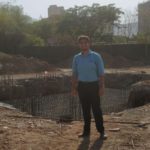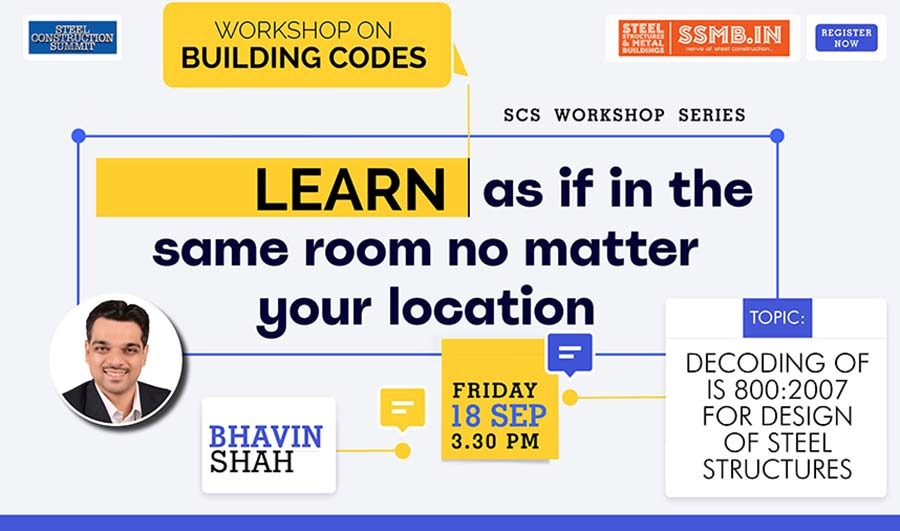In the next session of 27-SEP-20, we are going to discuss the stiffness modifiers as per IS 16700, IS 15988 and IS 1893. Earlier, I received interesting questions at LinkedIn regarding the stiffness modifiers. I have given the answers based on my understanding. Few of them are reproduced below.
Link for attending live session of 27-SEP-20 : https://youtu.be/wEom_O1i7LY
Your views / suggestions / comments are welcome in the comment box below.
Why no stiffness modifiers for wind and other load cases, cracks can occur in other loads cases also which in turn increase the deflections ?
his is a very good question. Let me try to explain this with the simple language based on my understanding. For wind resistant design, the structure is designed to resist wind load under elastic limit. However, for earthquake resistant design, it is not economically feasible to design the structure to resist the earthquake loads under elastic limit. Hence, during extreme seismic event, the structure is expected to experience the inelastic displacements. In view of the above, the structure will be under elastic stress for the wind load case and will be designed to respond inelastically under the effect of earthquake loads. Due to the same, stiffness modifier concept might not have been considered for the wind resistant design for buildings less than 50m height (IS 1893 (Part 1) : 2016). IS 16700 : 2017 defines stiffness modifiers for wind load case as well (table no. 6).
stiffness modifiers are independent to the nature of the force but they are dependent upon the extent of cracks in the member. The structures are designed to resist the wind force within elastic limit whereas for earthquake resistant design, the structure has to undergo inelastic displacement. Due to this the extent of cracks will be lesser in the structural members for wind resistant design as compared to the earthquake resistant design. Hence, the stiffness modifiers values are different for wind load and earthquake load.
Clause no 1.4 says, IS16700 can also be used to design building under 50 m but in no case, it should be used to design building having a height greater than 250m. Please do comment on this.
For buildings having height up to 50m, IS 1893 (Part 1) : 2016 to be referred. IS 16700 : 2017 to be referred for buildings of height greater than 50m but less than or equal to 250m. It is mentioned in Cl. no. 1.4 of IS 16700 : 2017 that the standard may be used for buildings of height equal to or less than 50m. It is recommended that IS 16700 : 2017 may be used for such buildings as it may add values to the design. However, it is not mandatory to use IS 16700 : 2017 for design of buildings up to height of 50m. It is mentioned in Cl. no. 1.4 of IS 16700 : 2017 that the standard is not applicable for buildings of height more than 250m. Buildings of height greater than 250m are considered as Super Tall Building (Cl. no. 3.13). I believe that special issues associated with the Super Tall buildings like safety of structure, serviceability criteria, different structural systems, wind effects, etc. might not have been covered in the code. Hence, it might have been mentioned that the code is not applicable for Super Tall Buildings.
Ultimately as per my understanding from the discussion, we have to prepare 2 nos frame analysis model from which 1st model is used for satisfying serviceability criteria in which we have to assign stiffness modifiers as per IS 1893 :2016 for building having height less than 45m.and as per IS 16700 if building height having height more than 45mt. and check serviceability criteria. In 2nd model for design in which don’t assign stiffness modifiers if building height less than 45m and assign Ultimate stiffness modifiers if building height greater than 45mt. Make me correct if, am I wrong?
Let me correct your understanding based on my experience. As per IS 1893 (Part 1) : 2016, only one model is required and the stiffness modifiers to be considered only for seismic load. As per IS 16700 : 2017, two separate models will be required as there are different stiffness modifiers for wind load (serviceability state) and seismic load (ultimate state). I hope it is clear. May share further doubts, if any.
In IS1893 we have different stiffness modifiers for slabs, beams, columns but in IS16700 table 7 that shows stiffness modifiers to be used during Sensitivity Analysis mentions same modifiers for slabs, beams and columns. Why so?
In IS 1893 (Part 1) : 2016, there are separate stiffness modifiers for beams and columns. IS 16700 : 2017 defines separate stiffness modifiers for slab, beam, column and wall in table no. 6 (Cl. no. 7.2). As per IS 16700 : 2017, the sensitivity analysis is to be performed for multiple tall buildings connected with a common podium (Cl. no. 8.1.3). Table 7 indicates stiffness modifiers to be used for upper and lower bound solution while performing the sensitivity analysis. The sensitivity analysis is to be performed in addition to the analysis based on the cracked RC section properties, as defined in Table no. 6 (Cl. no. 7.2). I hope it answers your query.
Though with respect to IS 16700: 2017 table 7 modifiers are in addition to table 6 modifiers but why same modifiers are considered for slabs, beams, columns, walls? While table 6 mentions different modifiers for slabs, beams, columns, walls. Table 6 has different modifiers for different structural elements because we consider slabs will have more cracks than beams and beams more than columns. But in table 7 the modifiers are same for all elements. Why so?
As per clause no. 8.1.3.2.1 of IS 16700 : 2017, the stiffness modifiers are defined for upper-bound and lower-bound cracked section properties of floor diaphragms and diaphragms & perimeter wall of podium. Hence, there are unique values of the stiffness modifier. For more details, pl refer to the clause.
In case if shear walls are only the lateral force resisting element then shall we not be considering reduced stiffness? ACI also suggests 70% stiffness for the walls. Hence stiffness modifier for the walls shall not be ignored.
I agree with your views that stiffness modifiers may be included for shear wall as well. I believe it may be included in the next revision of the code.
Please correct me if I’m wrong, “stiffness modifier is a bi-product of stiffness reduction due to crack formation in concrete structures”. If we’re well positioned in terms of assuring conformance with crack-width criteria, in a sense resulting crack-width is well with in the permissible limit, under such scenario would you be still advocating such a tremendous reduction of portal stiffness?
As per my understanding the values might have been derived based on testing of the structures which are designed using conventional limit state design method principles. I think if we are limiting the crack widths as per requirements of un-cracked concrete then the values of stiffness modifiers may be increased. However, at present in the code, there are no different values of the modifiers defined for the structures which are designed considering the principles of un-cracked concrete.
Is this stiffness reduction “part-and-parcel” of serviceability checks since crack formation by-and-large activates such reductions in stiffness? Looks like, strength checks [Flexure/Shear etc] would remain unaffected by this substantial stiffness reduction.
As I understand that the stiffness modifiers are to be used only for structural analysis. After deriving the analysis results, the flexural / shear design to be performed using the conventional procedure of limit state design method.
From Analysis Point Of View Can We Take I as 1 and Run The Model And Take Out The Base Reactions Using That Model?? From Design Point Of View We Can Save As Model And Apply Stiffness MODIFIERS As Mentioned In The Code And Carry Out Design Procedure??
In IS 1893 (Part 1) : 2016, stiffness modifiers are defined for structural analysis for seismic load case. The analysis results to be derived considering the stiffness modifiers. Thereafter, the design to be performed as per the conventional procedure.
I would like to ask that if there are cracks on the structure in service life (I am talking about old structure), then how to calculate its effect on the strength reduction of that member or in building analysis. Can we use stiffness modifier in that case by considering it for serviceability? Presume that I have analysis and design model of the original structure. Or any other Idea that how to analyse the old damaged structure (after obtaining required NDT results) and redesign it for Jacketing or wrapping?
Stiffness modifiers are defined with a fact that the RC structural elements would have cracks during their service life. For seismic evaluation and retrofitting of the existing RCC structures, you can refer IS 15988:2013.
By providing smf we can distribute the loads also. Is it true?
The intention for introducing the stiffness modifier is not for load distribution, instead it is to account for reduced moment of inertia of different members due to cracking.
If overall stiffness of building reduces and mass remains same then how overall seismic force on building going to reduce. Please clarify
The seismic force values are inversely proportional to time period of the building, i.e. higher the time period lesser is the seismic force. The time period is again inversely proportional to the stiffness of the structure. Hence, even if for the constant mass values, relatively lower stiffness will result in the higher time period and the higher time period will reduce the seismic force on the structure. I hope it will clarify your doubts.
Bhavin Shah
Founder & CEO, SQVe Consultants
__________________________________________________________
Part values of modifiers from different IS codes are given below. For more details, please refer relevant clauses and table of the above mentioned codes.
IS 15988:2013 Table 2 Some Effective Stiffness Values
(Clause 7.2.3)
Flexural Rigidity
- Beam, non pre-stressed……………………….. 0.5
- Beam, pre-stressed ……………………………… 1.0
- Column in compression(P > 0.5fc’Ag)…….0.7
- Column in compression (P > 0.5fc’Ag )…..0.5
- Walls — Uncracked ……………………………. 0.8
- Walls — Cracked ……………………………….. 0.5
- Flat slab To be determined based on rational procedure
IS 16700:2017 – Table 6 -Cracked RC section properties
(clause no. 7.2)
Element Unfactored loads Factored loads
- Slab 0.35 0.25
- Beams 0.7 0.35
- Columns 0.9 0.70
- Walls 0.9 0.70
IS 16700 : 2017 – Table 7 Stiffness Parameters
Clause no. 8.1.3.2.1 (a)
Diaphragms & Perimeter walls of podium and below the level
Of backstay – Ieff / Ig – 0.5 (upper bound) , 0.15 (lower bound)
____________________________________________________
An online course related to stiffness modifiers will start from 22-JUN-22.
Click below for more details and registration for EQ-STR-003
Feedback of participants from the previous online courses:




































